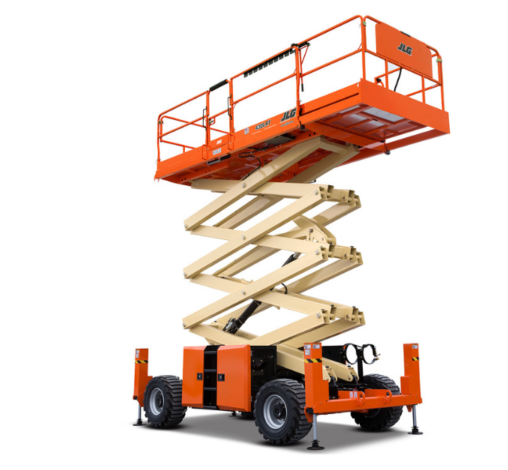How to Operate a Scissor Lift Safely
Scissor lifts are among the most popular aerial lifts, and for good reason. They feature an extendable platform and crisscross framework well-suited for construction, electrical work, building maintenance, and other industrial applications. They are mobile, compact, and offer a large, stable platform that is both safe and provides ample space. Scissor lifts tend to be smaller than other types of aerial lifts, too. Any worker who uses a scissor lift must receive proper safety training.
There is a lot to like about scissor lifts. But, to realize their full benefits, it is crucial to teach workers how to operate a scissor lift.


How to Operate a Scissor Lift: Do’s and Don’ts
Scissor lift controls can be tricky, regardless of an operator’s experience. A clear understanding of scissor lift do’s and don’ts can help an operator avoid accidents.
Here are common do’s and don’t for how to operate a scissor lift:
Do’s
- Conduct an in-depth inspection. Part of learning how to operate a scissor lift comes down to thorough reviews of the machinery before you even turn it on. Verify that a scissor lift is in proper working order before using it. If any issues are identified, take the machine out of service. At this point, the lift should not be returned to service until it has been repaired by a qualified technician.
- Assess the work area. Keep an eye out for uneven terrain. Remember, a scissor lift can easily become unstable and tip over if an operator drives it too fast or turns too quickly while traveling over uneven terrain. Meanwhile, a scissor lift operator should watch for any other work area hazards as well.
- Maintain the lift’s guardrails. Experts who know how to use a scissor lift will tell you just how vital it is to check that a lift’s guardrails are intact. If an operator intends to work outside the guardrails, he or she should always wear fall protection equipment. Otherwise, this operator risks falls that can result in serious injury or death.
- Travel at a safe speed. Watch for posted speed limits for scissor lifts at worksites. A scissor lift operator should always lower their lift’s basket before moving their machine as well.
- Use safety chains as needed. Utilize safety chains for any tools stored inside of a scissor lift’s basket. Because, if tools inadvertently fall out of a lift, they can put anyone beneath the machine in danger.
- Verify the lift’s load capacity. Much of learning how to drive a scissor lift boils down to understanding your load capacity limitations. This varies based on the model. Validate the lift’s load capacity before using the machine.
- Maintain a valid license. Scissor lift operators can earn OSHA certification at any time. This certification stays valid for up to three years and must be renewed to ensure an operator can legally drive a lift.
Don’ts
- Keep the gates open. Ensure the gates at the back of a scissor lift are always closed.
- Put ladders or step stools in the scissor lift’s basket. Avoid using ladders and step stools inside the lift’s basket.
- Climb or lean on the guardrails. Operators can use a lift’s guardrails to maintain balance inside the machine, but they should not climb or lean on them.
- Watch for inclement weather conditions. Keep an eye on the weather forecast. If the weather calls for heavy winds, rain, snow, or other harsh conditions, do not let workers operate scissor lifts. Instead, wait for the weather conditions to improve before allowing operators to use scissor lifts outdoors.
Learning how to operate a scissor lift with safety top of mind is vital. If your employees are uncertain about how to move a scissor lift, they put themselves and others at risk of scissor lift accidents and injuries.
OSHA requires employers to teach workers how to operate a scissor lift. By offering scissor lift safety training classes, an employer can teach its workers the proper techniques and strategies for how to use a scissor lift.
Tips for How to Drive a Scissor Lift
If you’re just learning how to drive a scissor lift, follow these tips to make the process as safe and easy as possible:
1. Focus on the Task at Hand
Scissor lift operators should focus exclusively on operating their lift to the best of their ability. They should follow all safety precautions, every time they use a lift. Always pay close attention to scissor lift controls if you’re hoping to avoid an accident.
2. Evaluate Your Lift
Assess a scissor lift before each use. If any problems are identified during an inspection, take the lift out of use until repairs are completed.
3. Follow the Capacity Limit
Much of learning how to operate a scissor lift comes down to understanding your limitations as an operator. Do not exceed a scissor lift’s capacity limit. Account for the weight of the operator and any tools before using a scissor lift.
4. Use Your Lift on Level Ground
Avoid using a scissor lift on unstable ground. Otherwise, there is an increased risk that the lift could tip over.


5. Do Not Use Your Lift in Harsh Weather Conditions
Curious about how to use a scissor lift in a storm? In most cases, it’s a bad idea. Never use a scissor lift in heavy winds or other inclement weather conditions. If a storm makes it unsafe to operate a lift, wait until the storm passes.
6. Keep Your Lift Away from Other Equipment
When using a scissor lift, maintain as much space as possible from other equipment. This minimizes the risk of bumping into other equipment.
7. Be Proactive
Do not leave anything to chance when learning how to drive a scissor lift. If any hazards are identified or problems arise that hinder an operator’s ability to safely use a scissor lift, they must be addressed immediately.
8. Make Maintenance a Priority
Consistent maintenance is a key factor in preventing scissor lift accidents and injuries. Scissor lift maintenance involves:
- Inspecting and testing lift controls and components before use
- Ensuring the lift’s guardrail system is in good working condition
- Ensuring the brakes are set and will hold the scissor lift in position
9. Be Mindful of Hazards
Common causes of scissor lift accidents include tip-overs, collapses, and malfunctions. However, OSHA-certified scissor lift operators can take steps to reduce or eliminate hazards that otherwise contribute to these issues. Ultimately, to safely use a scissor lift, operators must focus on fall protection, stability, and positioning.
Scissor Lift Controls
Scissor lifts have several different components. The power source, the base, the cylinder that powers the legs, the platform, and the scissor legs are all controlled by scissor lift controls. They’re present on the platform and the base. These switches allow operators to control different functions of the lift. While every model is slightly different, most contain these primary controls:
Base Controls
- Emergency stop button — Cut the power to the scissor lift control circuit by pulling the emergency stop button.
- Key switch — This allows you to operate the scissor lift from the platform console, bottom panel, or both. When left in the neutral position, the key witch allows you to operate from either panel.
- Lower-neutral-raise switch — Lower or raise the platform using this switch. You can also keep it in the neutral position.
- Indoor and outdoor settings buttons — Some models include a control that allows you t choose between outdoor and indoor settings.
Platform Controls
- Mode selector — This scissor lift control allows operators to drive the platform or raise and lower it.
- Key switch — This allows you to turn your lift on or off from the platform.
- Joystick — Upon moving the mode selector to the right setting, use the joystick to manuever the lift. In drive mode, you can move the joystick forward to go forward, while pulling back reverses it. Lift mode allows you to pull the stick backway to elevate the platform, while pushing forward lowers it.
- Emergency stop button — Hit this button to cease all operations.
- Speed switch — Adjust how quickly or slowly your machine can move.
- Steering — Turn the wheels to the left or right to steer.
- Horn — This helps you to warn others that you’re adjusting the lift or moving.
Scissor Lift Operation: How to Move a Scissor Lift
Knowing how to move a scissor lift comes with a lot of practice. As you get your handle on how to achieve this, make sure the surface is level first. Confirm a manager is available to oversee the move, then make sure outrigger frames are installed on both sides of the scissor lift.
Next, you’ll want to ensure a power system is being applied directly to the wheels. Avoid moving more than one foot per second. Workers should not be on any part of the scaffold that extends towards the casters, wheels or other supports. Keep the lift at a height that’s double the width of the base and apply manual force to move it as close to the base as possible. You want it to be no higher than five feet about the supporting surface.
Always be sure employees on or near the scissor lift are made aware of the move. If any of these requirements can’t be met, workers should get down before the lift is moved.
Can Anyone Learn How to Drive a Scissor Lift?
Learning how to operate a scissor lift is easier than you might expect. Still, there are certain requirements you must meet before you begin using them. OSHA requires scissor lift operators to complete a scissor lift training course that verifies they can safely and reliably drive a lift. As such, only an operator who has completed an OSHA-compliant safety training program should drive a scissor lift.
It is an employer’s responsibility to ensure that only OSHA-compliant operators use scissor lifts. In the event that an unauthorized worker uses a scissor lift, their employer could face OSHA fines and penalties. Even worse, the worker could inadvertently put himself or herself and others in danger.



Learn How to Operate a Scissor Lift Today
Learning how to operate a scissor lift is a relatively straightforward process. Simply learning the ropes isn’t enough, though. OSHA requires all operators be formally trained and certified before they’re allowed to use a scissor lift. Training programs can help you learn the ropes quickly. Employers are responsible for providing training opportunities.
CertifyMeOnline.net offers comprehensive training that covers everything from how to best handle materials to staying safe in the face of worksite hazards. If you’re hoping to train your team as quickly as possible, you can sign up today. Our 24/7 online training is OSHA compliant and convenient for workers. In as little as an hour, your team can learn all they need to know about how to drive a scissor lift. To learn more or register, contact us online or give us a call at (602) 277-0615.
